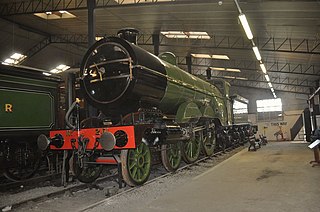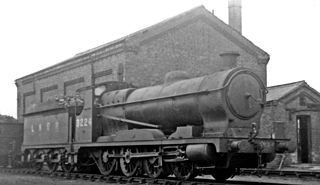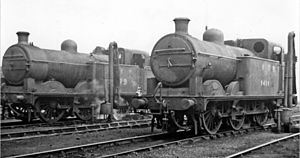John George Robinson CBE, was an English railway engineer, and was chief mechanical engineer of the Great Central Railway from 1900 to 1922.
The London and North Eastern Railway (LNER) produced several classes of locomotive, mostly to the designs of Nigel Gresley, characterised by a three-cylinder layout with a parallel boiler and round-topped firebox. It produced the most famous locomotive of its day, 4468 'Mallard', the holder of the world steam locomotive speed record. It also built the world-famous 4472 'Flying Scotsman'. However, its locomotive inheritance was much greater than just the 'A4 Class', it also produced highly successful mixed-traffic and freight designs.

The Great Northern Railway (GNR) Small Boiler Class C1 is a class of steam locomotive, the first 4-4-2 or Atlantic type in Great Britain. They were designed by Henry Ivatt in 1897. In total 22 were built between 1898 and 1903 at Doncaster Works. The class were commonly known as 'Klondykes' [sic], after the 1897 Klondike gold rush. They could reach speeds of up to 90 mph. They were also known as Small Atlantics.

London and North Eastern Railway's (LNER) Peppercorn Class A1 is a class of 4-6-2 "Pacific" steam locomotives built between 1948 and 1949 at Doncaster and Darlington Works to a design of Arthur Peppercorn. Forty-nine were built for hauling express passenger services on the East Coast Main Line owned by LNER's successor, British Railways' North Eastern Region. None of the original Peppercorn A1s survived into preservation, with the last being scrapped in 1966. The 50th Peppercorn A1, 60163 Tornado, was completed in 2008 as an evolved member of its class.

The Great Northern Railway Class J23 was a class of 0-6-0T steam locomotive. They had long side tanks that came to the front of the smokebox, which sloped forwards to improve visibility and had a recess cut in to aid maintenance. Forty were built by the Great Northern Railway (GNR) between 1913 and 1922, with a further 62 being added by the London and North Eastern Railway (LNER) between 1924 and 1939. They were given the nickname "Submarines" due to their long tanks.

The GER Class L77, LNER Class N7, is a class of 0-6-2T steam locomotives. They were designed by Alfred John Hill of the Great Eastern Railway and introduced in 1915. The design was perpetuated by Nigel Gresley of the LNER after the 1923 grouping. 134 were built and one example is preserved.

The Great Central Railway (GCR) Class 9F was a class of 0-6-2T steam locomotive built between 1891 and 1901. From 1923 the locomotives were redesignated Class N5.

The Metropolitan Railway K Class consisted of six 2-6-4T steam locomotives, numbered 111 to 116.

The Great Northern Railway (GNR) Class N2 is an 0-6-2T side tank steam locomotive designed by Nigel Gresley and introduced in 1920. Further batches were built by the London and North Eastern Railway from 1925. They had superheaters and piston valves driven by Stephenson valve gear.

The Great Northern Railway (GNR) Class C1 is a type of 4-4-2 steam locomotive. One, ex GNR 251, later LNER 2800, survives in preservation. Much like their small boiler cousins, they were capable of reaching speeds of up to 90 mph (145 km/h). They were also known as Large Atlantics.

The Great Northern Railway (GNR) Class O2 was a class of three-cylinder 2-8-0 steam locomotives designed by Nigel Gresley for freight work and built by the GNR from 1921. Further examples were built by the London and North Eastern Railway (LNER) from 1924.

The North Eastern Railway (NER) Class H, classified as Class Y7 by the London and North Eastern Railway (LNER) is a class of 0-4-0T steam locomotives designed for shunting.

The NER Class X was a class of 4-8-0T tank locomotive designed by Wilson Worsdell for the North Eastern Railway. They were intended for use as powerful shunting engines to arrange and move coal wagons for loading into ships. In total 15 were built, 10 by the NER between 1909 and 1910, and a further five in 1925 by the London and North Eastern Railway (LNER). They had three cylinders with divided drive: the inside cylinder driving the leading axle, the outside cylinders driving the centre.

The Great Northern Railway Class H2 and H3 was a class of 2-6-0 steam locomotive designed for mixed-traffic work.

The Great Central Railway (GCR) Class 8A was a class of 0-8-0 steam locomotive built between 1902 and 1911 for handling heavy coal trains over the Pennines. They all passed to the LNER in 1923, who redesignated them Class Q4. They were withdrawn from service between 1934 and 1951.

The GCR Class 1B was a class of 2-6-4T (tank) locomotives on the Great Central Railway. They were notable as the first locomotives of the 2-6-4T wheel arrangement to be used by a British standard-gauge railway; there had been two narrow-gauge examples on the Leek & Manifold Valley Light Railway since 1904.
The LD&ECR Class D was a class of nine 0-6-4T steam locomotives supplied to the Lancashire, Derbyshire and East Coast Railway in 1904 and 1906 by Kitson & Co. of Leeds. They later became the property of the Great Central Railway and finally the London and North Eastern Railway, upon which they were known as Class M1.

The Great Northern Railway (GNR) Class L1 was a 0-8-2T side tank steam locomotive designed by Henry Ivatt. It was originally designed for suburban passenger traffic on the Metropolitan City Lines.

The Great Central Railway (GCR) Class 9A was a class of 0-6-2T steam locomotive built between 1889 and 1892. From 1923 the locomotives were redesignated Class N4.

















